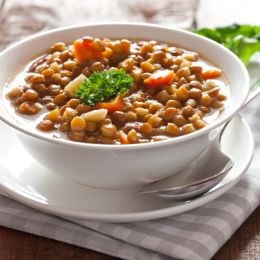Bounce Back from an Illness Faster: A 3-Step Plan
Good nutrition is the key to a quicker recovery.

By K. Aleisha Fetters
The best way to come out of an illness feeling better than ever is to head into it with a foundation of good health.
“When my 90-year-old grandfather had intestinal bleeding, he was in and out of the hospital in two days,” says dietitian Wesley Delbridge, R.D., a spokesperson for the Academy of Nutrition and Dietetics. “The fact that he had taken such good care of himself beforehand made such a difference.”
Unfortunately, most of us don’t think that much about recovering from the sniffles (or something more serious) until we’re laid up in bed, he says. Then our focus is laser-like: What’s the fastest way to get back on our feet?
The answer: good nutrition. “Not only does the right nutrition help with certain health outcomes, such as improved immunity, but it also gives your body the energy and building blocks it needs to recover from an illness,” says Suzette Pereira, Ph.D., a research fellow specializing in muscle health at Abbott.
In fact, getting proper nutrition when you’re in the hospital results in shorter stays and a reduced risk of readmission, according to a 2016 study in the Journal of Parenteral and Enteral Nutrition.
So, what does good nutrition look like when you’re sick in bed? Try this simple three-step plan.
Step 1: Eat, Even If You Don’t Feel Hungry
When you’re not feeling well, this one can be tough to swallow. But your body needs energy—in the form of calories—to fuel its fight.
Recent research in Critical Care shows that during illnesses, especially severe ones, the number of calories you require per day can significantly increase—even if you’re bedridden.
If you don’t have much of an appetite, Pereira recommends trying out different foods in the morning, when you’re likely to feel your best. And don’t limit yourself to traditional breakfast foods. If you want a chicken breast at 8 a.m., go for it. Also, if large meals make you feel queasy, breaking them into small snacks may help.
Step 2: Pump Up Your Protein Intake
“Illness can often lead to muscle loss,” Pereira says. “In fact, when you’re on bed rest, you can lose muscle mass up to three times faster than you would otherwise.” Muscle losses can result in poor strength and mobility, preventing you from returning to the activities you love.
When your appetite wanes with illness, your desire for protein-rich foods such as meat and dairy are the first to go, Delbridge says. If that happens, consider supplementing with protein shakes. Many come with the added benefit of HMB (beta-hydroxy-beta-methylbutyrate), a compound that has been shown to help preserve levels of muscle mass in older adults hospitalized for 10 days.
Subscribe to our newsletter
It's quick and easy. You could be one of the 13 million people who are eligible.
Already a member? Click to discover our 15,000+ participating locations.
Follow Us
No matter how you get your protein, it’s wise to try to space it throughout the day, Pereira says. Your body uses protein by breaking it down into amino acids. By spreading your protein intake over the course of the day, you’ll keep your muscles fueled with a steady stream of amino acids.
Step 3: Stay Hydrated with Soups
“Water helps keep your blood flowing, carries nutrients and oxygen to your cells, and protects your joints,” Pereira says. “As your body recovers from an illness, it sends water and nutrients to those locations.”
So if you’re not replenishing fluids, the wound healing and cell repair processes take longer and can ultimately hinder your recovery.
If drinking straight water doesn’t sound appealing, try to eat plenty of low-sodium, veggie-rich soup. It’s great for increasing hydration levels, and it can pack plenty of nutrients.
In other words, mom was right: Chicken noodle soup may be the cure for what ails you.





